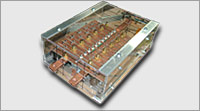Open ReVolt
Contents
- 1 Quick Links - Active Open ReVolt Wiki Projects
- 2 Open ReVolt Disclaimer
- 3 Frequently Asked Questions
- 4 Open ReVolt projects
- 5 EV 500 & 1000 Amp DC Motor Controller "ReVolt" Features
- 6 AC Motor Controller Features
- 7 EV LCD Instrumentation Features
- 8 EV 6Kw DC Charger Controller Features
- 9 EV BMS Controller Features
Quick Links - Active Open ReVolt Wiki Projects
*** Open ReVolt Projects - BOM, Firmware, PCB and Schematic Files ***
*** Open ReVolt Project - Fabrication Files ***
Open ReVolt Disclaimer
- The Open ReVolt “projects” on this Wiki carry no warranty or guarantee of any kind!
- The electronics and software on this Open ReVolt Wiki have been produced for the benefit of the DIY EV & electronics community.
- The electronics and software on this Open ReVolt Wiki are available as “open source” for all to user’s or modify or adapt as they see fit; no claims are made to their suitability for any particular function.
- All Open ReVolt electronics and software “projects” on this Wiki are to be used at the user’s own risk; the user should question their experience level before starting a project.
- If user’s are not fully competent to work on “POTENTIALLY LETHAL HIGH VOLTAGE” battery systems then “DO NOT EXPERIMENT” with the Open ReVolt “projects” on this Wiki.
- Prospective users will be accepting personal risk when starting an Open ReVolt “project”, all liability will be exclusively assumed by that user and will not carry over to any other user.
- Be aware that users risk of vehicle modifications could lead to invalidated insurance and warranty issues. The user is fully liable for any modifications made to the vehicle.
As the name would imply, Open ReVolt is open, which means all EV Electronics development here happens online for everyone to see. Want to know what a certain circuit, part, or code for this project does and why? It's all in this Wiki and on the Forum. In the forum many, many people with different experience levels from all over the world share their new ideas, and suggestions for improvements by watching Open ReVolt Projects for mistakes and potential problems. That could be your input too !!!
The goal of the "Open ReVolt Project" is to make quality and reliable EV Electronics at an Affordable cost for Amateur EV Conversion. That means being smart with what components are called for, group buying to drive down cost, and taking advantage of generously donated parts, time, and resources.
The Open ReVolt "Cougar" DC motor controller is a PWM-type motor controller designed for sending power to series-wound type DC motors. In its base form, when built using the Bills of Materials for the control board and the power board, its components are rated to a 200V maximum voltage, and can handle up to 500 or 1000 Amps peak power throughput.
NOTE: In order to prevent blowout of components and leave some "safety room" in the controller, a maximum battery pack voltage of 144V is recommended.
The Open ReVolt is designed to be as modular as possible. A control board houses all the low-voltage electronics - such as microcontrollers, data cables, and throttle cables. A power board contains the MOSFETs, capacitors, and diodes, as well as the bus bars which connect to the motor and batteries. To protect the control board from the high voltage components, it is connected to the power board with an optoisolator. The control board uses its own separate 12V battery for power, instead of needing a high-voltage capable DC to DC converter. This helps to reduce cost and simplify the design.
Since the two boards are modular, you can size the power board for your vehicle without affecting the control board. An electric bike and an electric lorry could use the same control board (simply by attaching it to a higher-current power board). The power board can accept any battery voltage from 0 to 144 V.
This wiki is a work in progress. If you've read through the thread and can contribute to building this wiki, please register and get to work!
Frequently Asked Questions
Open ReVolt projects
>EV 500 Amp DC Motor Controller PCB & Mosfet Power PCBs are at Rev2c and here on the wiki.
>EV 1000 Amp DC Motor Controller, Mosfet Power PCB, and Mosfet Driver PCB are on wiki, preliminary development is on going.
>EV AC Motor Controller PCB - is on wiki, preliminary development is on going.
>EV DC LCD Instrumentation PCB - is now on wiki !!!
>EV 6Kw DC Charger Controller PCB - is on wiki, preliminary development is on going.
>EV BMS Controller PCB - Was added to the wiki !!!
>EV IGBT Driver PCB - Was added to the wiki !!!
* Planned Future Open ReVolt projects *
> The Uprising EV Series DC Motor Controller, and IGBT Driver PCB is on wiki, preliminary development is on going.
EV 500 & 1000 Amp DC Motor Controller "ReVolt" Features
- Continuous current rating of 500 or 1000 Amps.
- Any voltage input in the range of 0 to 144v.
- 15.6 kHz switching frequency.
- Adjustable hardware overcurrent shutdown.
- Hardware over-current shuts down in 3-4 µs. [1]
- RS-232 interface.
- Reprogrammable.
- High pedal lockout.
- The controller will not close the main contactor if the mosfets have failed shorted.
- Protection from many potentially destructive errors: [2]
- Control board power polarity reversed
- 12V supply connected to throttle
- Full throttle at 0 RPM
For a more detailed description of what each feature is and does, please see the Current Features page.
AC Motor Controller Features
- Hardware overcurrent protection - Regen can be set anywhere from 0 to 300 amps per phase.
- Positive amp draw limit per phase can be set anywhere in 0 to 300 amps.
- Isolated PWM Drivers (6) - Firmware configurable for ACIM, PMSM, SEPEX, SR, DC motor control.
- Configurations currently supported - ACIM & PMSM motor control.
- Individual Driver DC-DC converters (6) - for scaleable power output (IGBT, MOSFET).
- Isolated driver supplies (6) - Low voltage cutout, (1) below 9v and all (6) drivers are disabled.
- Thermal protection on-board.
- Built in contactor and precharge resistor control.
- Throttle control.
- Communication - RS-232, ISP.
EV LCD Instrumentation Features
- The display is 2 line x 16 character backlit LCD with oversized characters
- It displays both readings taken with local A/D and information transmitted serially from the Cougar.
- Displayed info includes:
- pack voltage (isolated circuitry) 0-204V range
- battery amps (Tamura hall sensor input or Cougar’s output) 0-511A range
- motor amps (Cougar output)
- accessory battery voltage
- motor temp in C or F (via thermistor)
- controller temp in C or F (Cougar output)
- pack temp in C or F (via thermistor)
- Other features:
- calculation & display of SOC based on battery amp usage (peukert is factored in).
- calculation & display of MTE (Miles to empty) based on %SOC per mile/km
- momentary switch to toggle between 2 profiles transmitted to controller
- “Mode” LED to indicate when controller runs with alternate profile
- “Overtemp” LED based on independent thresholds for the 3 measured temps
- Alarm output (NPN sinking)
- PWM output of SOC to interface to existing analog fuel gauge
- Canbus and RS232 interfaces (E-Can controller is integrated in the PIC)
EV 6Kw DC Charger Controller Features
- Modular design - The control board uses a remote current sense and voltage sense board that allows for high resolution measurement using an energy metering IC. You can daisy chain up to 3 of these boards to the main controller to measure all the sources inside the controller. These would be AC input voltage and current, Power Factor Corrected DC voltage and current, and the only board that is required is DC output to batteries voltage and current. These boards can measure up to 400VDc or 264VAC RMS
- Modular Driver - The driver output section is designed to be customized to your needs, Mosfet or IGBT.
- Graphic Interface - LCD Display is used to select the charging profile.
- Simple Interface - A rotary knob next to the LCD is used to select an item on the LCD display, Then pushing the knob to select or set that item.
- BMS Input - the simple BMS signal that can be either 5 or 12 volts (Jumper Selectable). The input can be used to stop charging when a BMS high cell condition is reached.
- Vehicle Interlock - You will be able to wire ignition or a contactor coil through this relay to disable the vehicle as soon as power is applied to the charger.
- Charger Contactor Control - This will be used to disconnect the battery pack from the charger when the charger is not charging.
- Ethernet Connectivity - The control board includes a 10TBase Ethernet connection for monitoring or communications.
- Software Features - You will be able to program for charging different vehicles with the same charger.
EV BMS Controller Features
- Distributed BMS, Master/Module system supports most popular LiFePo4 Battery Cells.
- Low cost digital BMS uses readily available PIC micros.
- Suitable for LiFePo4 cells with voltages from 2.5V to 4.0V
- BMS Module bolts on LiFePo4 cell terminals, 61mm mounting centers.
- BMS System can handle up to 150 LifePo4 cells.
- Low current drain ~ 1 mA per cell.
- Low voltage alarm.
- Loss of communications alarm.
- Measures all cell voltages and displays the highest and lowest.
- Measures all cell temperatures and displays the highest and lowest.
- Does bottom balancing of cells as required with a balancing current of ~ .5A (1/2 A).
- Balancing automatically cancelled if communications lost (prevents cells being discharged in the event of failure).
- Can shut off charger when one cell reaches max voltage.
The Open ReVolt Project: Wiki main page | Paul's website | Forum thread | Donate

